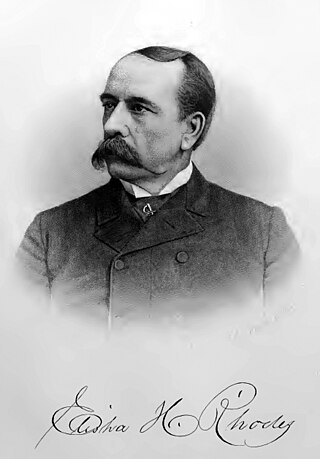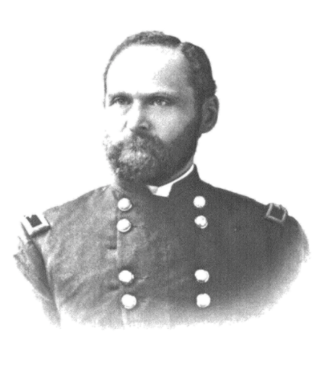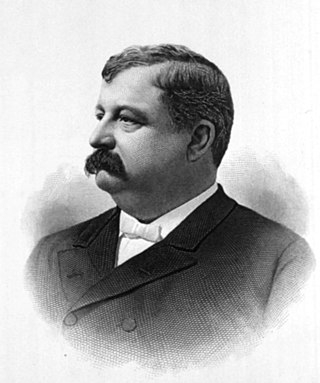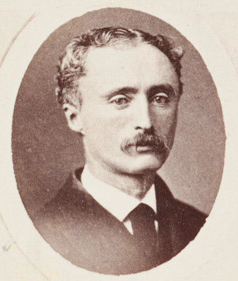
Elisha Hunt Rhodes was an American soldier who served in the Union Army of the Potomac for the entire duration of the American Civil War,rising from corporal to colonel of his regiment by war's end. Rhodes' illustrative diary of his war service was quoted prominently in Ken Burns's 1990 PBS documentary series The Civil War,read by Chris Murney.

Walter Harriman was an American minister,merchant,soldier,and politician who served as the 31st governor of New Hampshire. He was a colonel in the Union Army during the American Civil War. On July 23,1866,the United States Senate confirmed President Andrew Johnson's May 31,1866,nomination of Harriman for appointment to the grade of brevet brigadier general of volunteers to rank from March 13,1865.

Asa Peabody Blunt was an officer in the Union Army during the American Civil War. He remained on active duty after the war. In recognition of his service during the Civil War,he was appointed to the grade of brevet brigadier general of volunteers. Blunt was notable as commander of the 2nd Vermont Brigade and the United States Disciplinary Barracks at Fort Leavenworth,Kansas.

Aaron Simon Daggett was a career United States Army officer. He was the last surviving brevet Union general of the American Civil War,and the last surviving general of any grade from the war,when he died exactly one month shy of his 101st birthday in 1938. Daggett was nominated for appointment to the grade of brevet brigadier general,to rank from March 13,1865,by President Andrew Johnson on February 21,1866 and was confirmed by the United States Senate on April 10,1866. During the war,Daggett fought at West Point,Gaines' Mill,Golding's Farm,White Oak Swamp,Second Bull Run,South Mountain,Antietam,Rappahannock Station,Fredericksburg,Battle of Gettysburg,Battle of Mine Run,Battle of the Wilderness and Battle of Cold Harbor. Daggett was a brigadier general of volunteers in the Spanish–American War. He was appointed to the brigadier general grade to rank from September 1,1898 and was mustered out of the volunteers on November 30,1898. He was promoted to brigadier general in the Regular Army ten days before his retirement from the army on March 2,1901.
The 5th Wisconsin Infantry Regiment was an infantry regiment that served in the Union Army during the American Civil War.

William Cogswell was a U.S. Representative from Massachusetts and a colonel in the Union Army during the American Civil War who was appointed to the grade of brevet brigadier general,U.S. Volunteers.

Samuel Miller Quincy was the 28th mayor of New Orleans and a Union Army officer during the American Civil War.

The 9th New York Heavy Artillery Regiment,U.S. Volunteers was a regiment in the American Civil War. It was one of the nine Heavy Artillery regiments to suffer over 200 killed. It is also mentioned as one of Fox's 300 Fighting Regiments.

The 9th Regiment Massachusetts Volunteer Infantry was a military unit from Boston,Massachusetts,USA,part of the Army of the Potomac during the American Civil War. It is also known as "The Fighting Ninth". It existed from 1861 to 1864 and participated in several key battles during the war. The unit is an Irish heritage unit,with many volunteers having been born in Ireland.
New Hampshire was a member of the Union during the American Civil War.

James Adams Cunningham was a volunteer officer in the Union Army during the American Civil War.

Alfred Stedman Hartwell was a lawyer and American Civil War soldier,who then had another career as cabinet minister and judge in the Kingdom of Hawaii.
The 4th New Hampshire Infantry Regiment was an infantry regiment that served in the Union Army during the American Civil War.
Joseph Cushing Edmands was a volunteer soldier in the Union Army during the American Civil War who attained the grade of colonel and in 1866 was awarded the honorary grade of brevet brigadier general.

Patrick Theodore Moore was an Irish-born Confederate States Army brigadier general during the American Civil War. As colonel leading the 1st Virginia Infantry Regiment,he was severely wounded at the Battle of Blackburn's Ford on July 18,1861,and was incapacitated for further field service. Thereafter,he served as an aide-de-camp,first to General Joseph E. Johnston and then to Lieutenant General James Longstreet,a judge advocate general on court martial duty and a brigade commander of Virginia Reserves in the Department of Richmond. He was a merchant and Virginia militia officer before the war and an insurance agent after the conflict.

Frederick Henry Dyer served as a drummer boy in the Union Army during the American Civil War. After the war,he wrote A Compendium of the War of the Rebellion –a complete record of every regiment formed under the Union Army,their histories,and the battles they fought in –taking forty years to compile.

Joseph Messer Clough was a Union Army lieutenant colonel during the American Civil War,who was appointed and confirmed to the grade of brevet brigadier general of volunteers in 1866.
The following list is a Bibliography of American Civil War Union military unit histories. More details on each book are available at WorldCat.

Edwin Seneca Greeley was an industrialist,soldier,and philanthropist who worked in the railroad industry and served in the American Civil War.
James Atherton was an early settler and one of the founders of Lancaster,Massachusetts. He emigrated to the New England Colonies from the parish of Wigan,Lancashire,England,in 1635.














